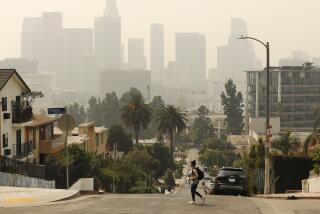Panel Calls for Alert on Risks of Passive Smoke : Health: EPA advisory committee declares it a known carcinogen. Workplace policies may be at stake.
- Share via
WASHINGTON — An independent scientific advisory panel to the Environmental Protection Agency Thursday declared secondhand smoke a known human carcinogen and recommended that the agency classify it as such.
“We were persuaded that there was a risk,” said Dr. Morton Lippmann, a professor of environmental medicine at New York University Medical Center and chairman of the panel.
The panel said that the biological activity of passive smoke, as well as its composition of cancer-causing agents, is similar to that of smoke inhaled directly and “the connection between direct inhalation of tobacco smoke and excess risk of lung cancer cannot be in doubt.”
Although “the inhalation of (environmental tobacco smoke) by children, by non-smokers or former smokers represents a risk that is much smaller than that experienced by smokers . . .it is an involuntary exposure,” said the committee, which evaluates the work of EPA studies.
EPA Administrator William K. Reilly will make the final decision of whether to categorize passive smoke as a Class A carcinogen, the most hazardous category of cancer-causing agents in humans. He is expected to act within several months.
The EPA, however, has no regulatory authority over indoor air pollution. The agency can only issue a health advisory, stating the danger and urging other regulatory agencies to take appropriate action.
Nevertheless, health groups predicted that such an advisory would have an enormous impact on policies in the workplace, schools and in day-care facilities, where daily exposure to passive smoke can be considerable. Such sites, they said, ultimately could be held liable for the consequences of passive smoke exposure.
Board members said that the extent of the risk is uncertain, but that occasional exposure probably produces little harm. Sustained, long-term exposure, on the other hand, enhances a non-smoker’s risk of lung cancer, they said.
The report was immediately hailed by health and anti-smoking organizations and condemned by the tobacco industry. Industry officials accused the panel of ignoring scientific studies that have indicated that there is no statistical increase in lung cancer because of passive smoke.
While the report based many of its conclusions on studies conducted on the non-smoking spouses of smokers, it took special note of those studies showing a risk for the children of smoking parents. The panel recommended that the final EPA report contain strong language on the harmful effects of passive smoke on children.
“It is possible that the impact of (environmental tobacco smoke) on respiratory health of children may have much greater public health significance than the impact on lung cancer in non-smokers,” the report said.
Fran DuMelle, deputy managing director of the American Lung Assn., said that the emphasis on children “means that agencies with special jurisdiction at the state level over the licensing of day-care facilities need to look at their smoking policies and that school boards will need to assess their policies regarding smoking on school property.”
She also predicted that workplace policies would undergo changes initiated either by employers or by the federal Occupational Health and Safety Administration, which has regulatory authority over the workplace.
“We don’t think any licensing agencies or employers need wait,” she said. “Whether or not laws are passed requiring them to change their policies, ultimately they are going to be liable.”
Walker Merryman, vice president of the Tobacco Institute, responded that “the panel has demonstrated a clear bias against evidence which does not fit its preconceived conclusion. The panel’s conclusions can only be described as irrational,” he said.
But anti-smoking groups hailed the report and its anticipated results.
“This is a huge step toward healthier air, healthier hearts and lungs and healthier Americans,” said DuMelle, speaking as chairman of the Coalition on Smoking OR Health, which is made up of the American Lung Assn., the American Heart Assn. and the American Cancer Society.
“There’s bad stuff in side stream smoke and nobody need be exposed to it,” she added. “Environmental tobacco smoke is the easiest indoor pollutant to deal with. You just don’t have smoking anymore. It’s not like the glue that holds down your carpeting or the particleboard in your furniture. It’s easy to remove it.”
More to Read
Sign up for Essential California
The most important California stories and recommendations in your inbox every morning.
You may occasionally receive promotional content from the Los Angeles Times.










